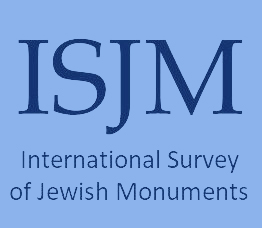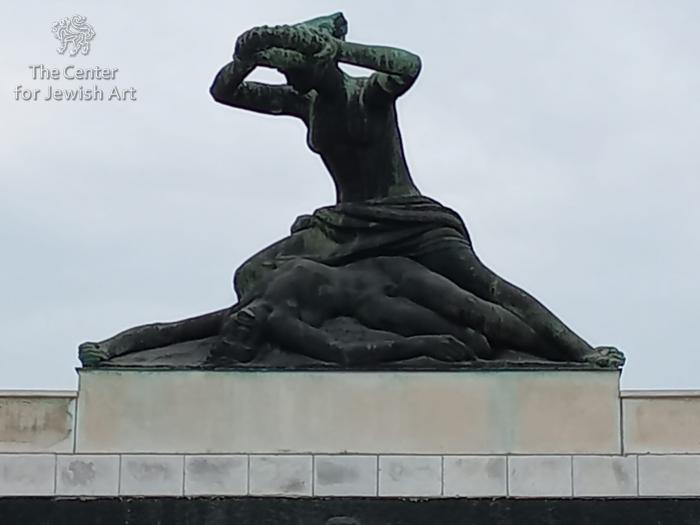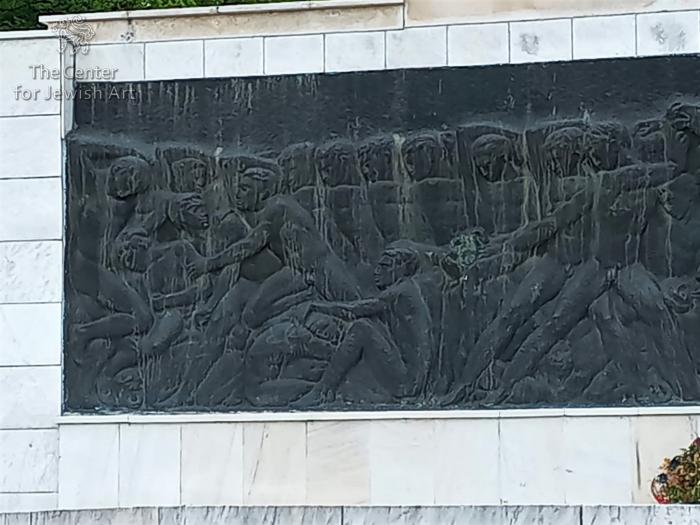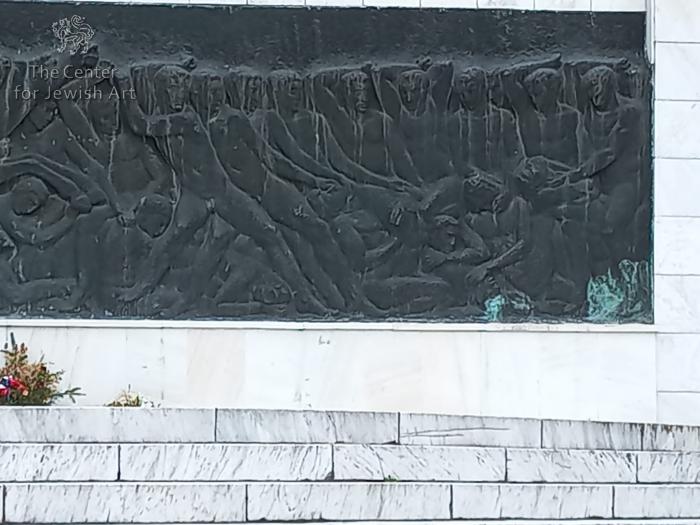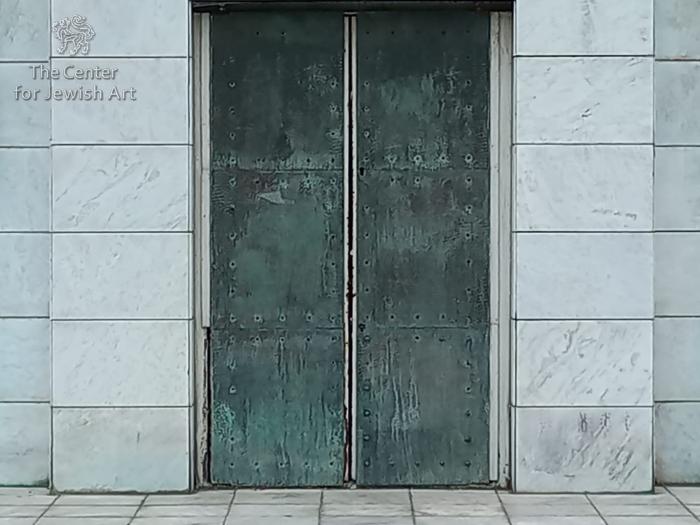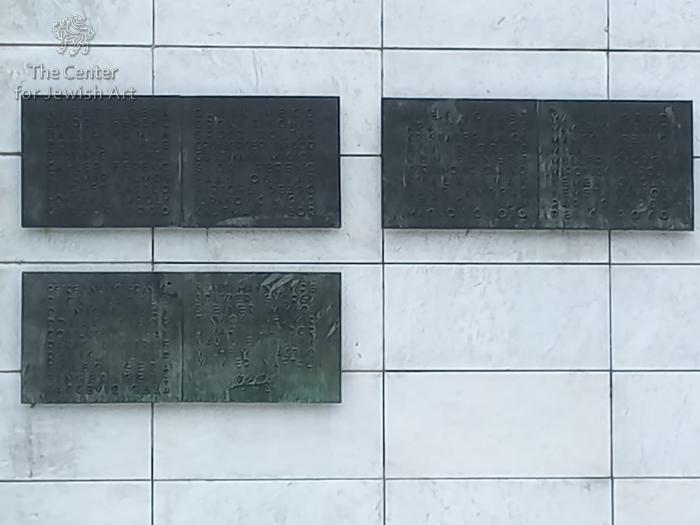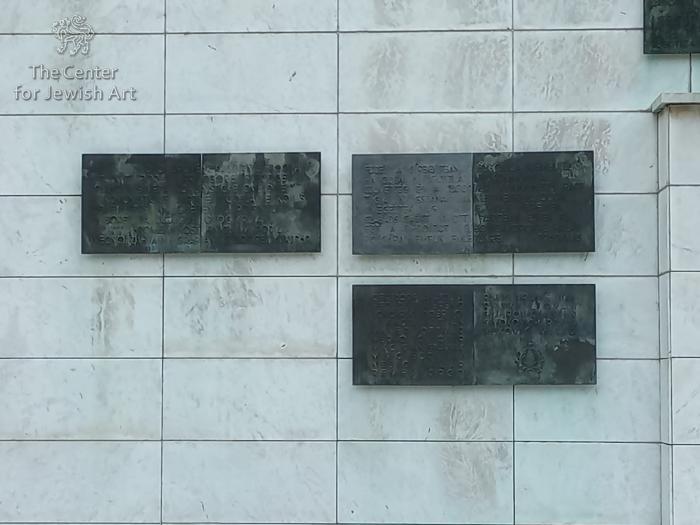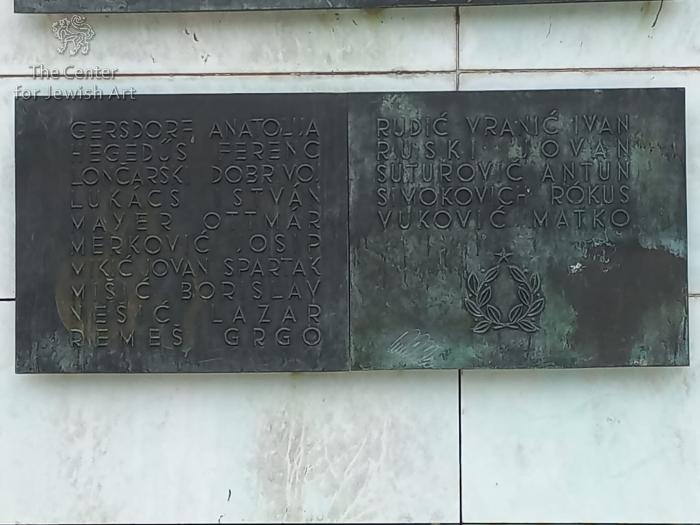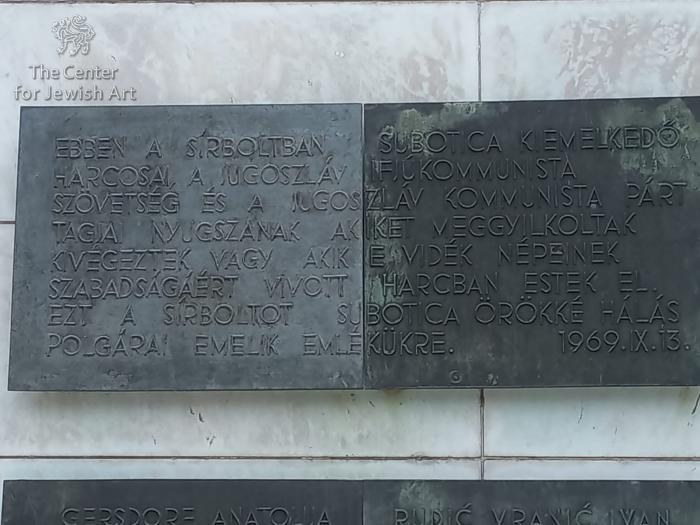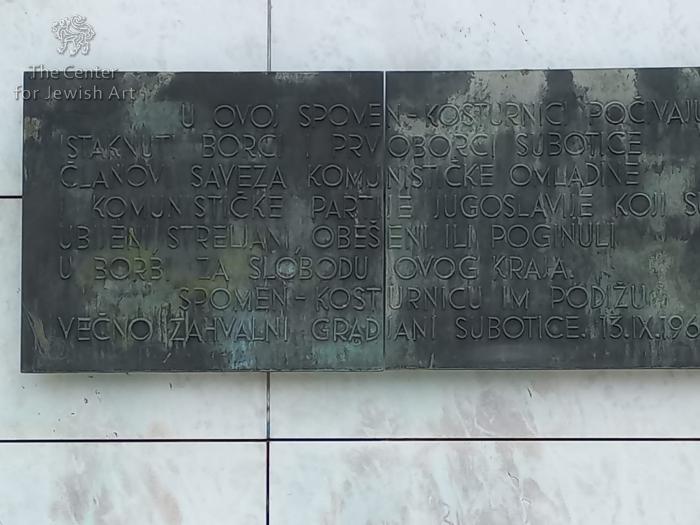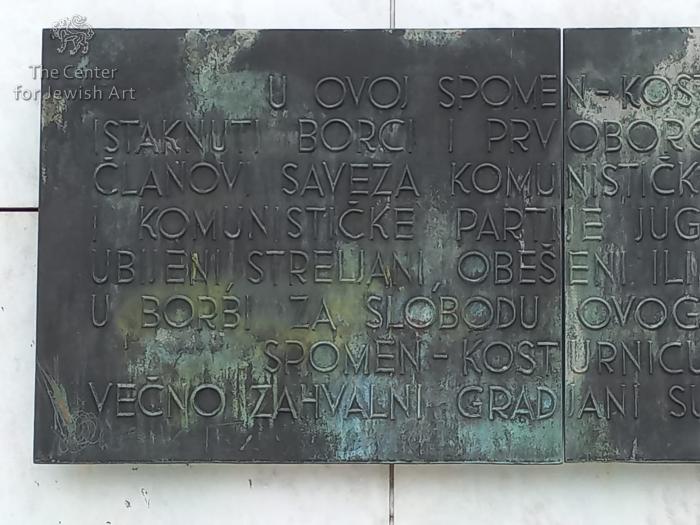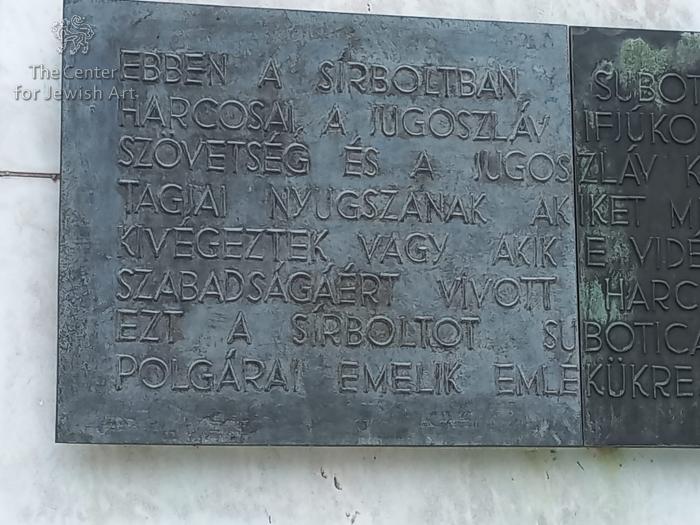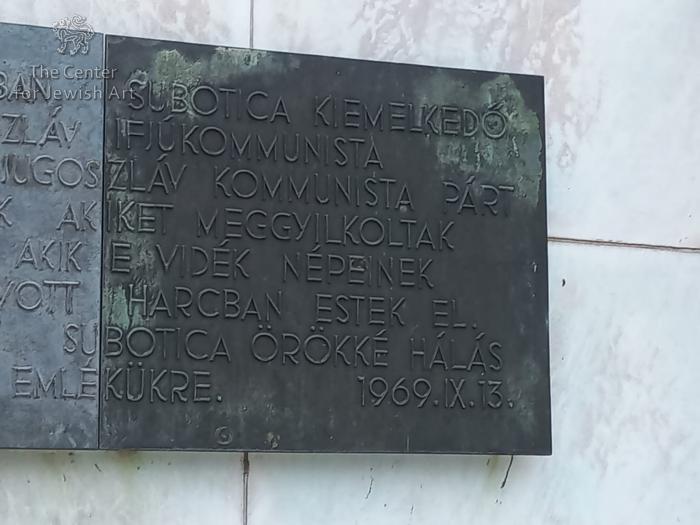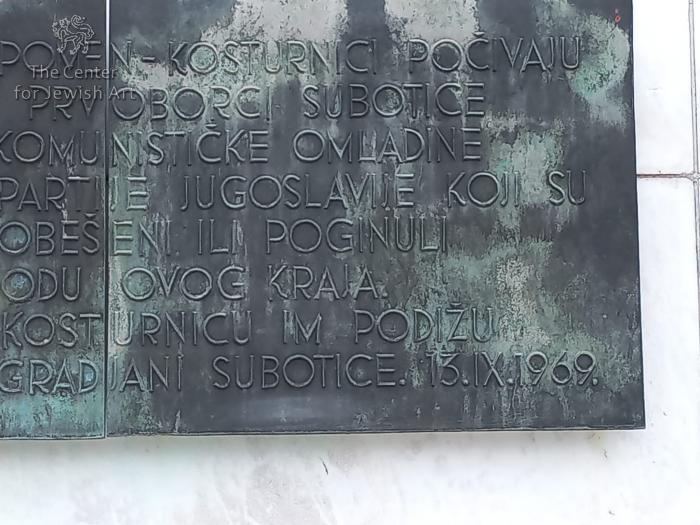Obj. ID: 50137 Monument to Fallen Soldiers and Victims of Fascism in Subotica, Serbia, 1946

Memorial Name
Monument to the Fallen Fighters and Victims of Fascist Terror of Subotica
Who is Comemmorated?
Revolutionaries killed during World War II in the fight for the liberation of Subotica
Description
The monument has three parts: a pedestal, an access plateau, and a crypt. The pedestal is made of a concrete base and brick, covered with marble (originally limestone). The plateau leads to the crypt that from the outside appears as a wall made of white marble with towers on both ends. It features a slightly curved bronze relief frieze on the front side depicting a battle.
The northern side of the wall structure serves as access to the crypt through centrally placed bronze doors. The crypt contains the remains of fifteen fallen citizens of Subotica. Above the door the years "1941-1945" are cast in bronze. Above and around the entrance are placed bronze plaques, 8 with commemorative inscriptions in Serbo-Croatian and Hungarian, and 8 with names of the fallen fighters and victims of fascism. A sculptural composition on top of the crypt, placed over the doorway, features a young woman and a fallen fighter, also made of bronze. The figures form a pyramidal composition, the woman crowning the lifeless corpse of the young man with a laurel wreath.
Inscriptions
1941-1945
Across two plaques (Serbo-Croatian)
U ovoj spomen-kosturnici počivaju
istaknuti borci i prvoborci Subotice
članovi Saveza Komunističke Omladine
i Komunističke Partije jugoslavije, koji su
ubijeni, streljani, obešeni ili poginuli
Translation: Prominent fighters and front-line fighters of Subotica, members of the Union of Communist Youth, and the Communist Party of Yugoslavia who were killed, shot, hanged, or died in the fight for the freedom of this region rest in this memorial crypt. The memorial crypt is erected by the eternally grateful citizens of Subotica. 13. 09.1969.
Across two plaques (Hungarian)
Ebben a sirboltban Subotica kiemelkedő
harcosai, a Jugoszláv Ifjukommunista
szövetség és a Jugoszláv Kommunista Párt
tagjai nyugszanak, akiket meggyilkoltak,
kivégeztek vagy akik e vidék népeinek
szabadságáért vivott harcban estek el.
Ezt a sirboltot Subotica örökké hálás
polgárai emelik emlékükre. 1969.IX 13.
Translation: In this crypt, outstanding fighters of Subotica, members of the Union of Communist Youth and the Communist Party of Yugoslavia, who were killed, executed or who died fighting for the freedom of the people of this region, rest. / This plaque is mounted in their memory by the ever-grateful citizens of Subotica. 13.09.1969
Across two plaques (Serbo-Croatian)
Na ovim pločama otrgnuta su od zaborava i
zabeležena za istoriju imena rodoljuba, antifašista,
boraca Narodnooslobodilačkog pokreta, članova
Saveza Komunističke Omladine i Komunističke Partije
Jugoslavije, koji su pomrli po nacističkim kazamatima
i koncentracionim logorima, poginuli kao politički
kažnjenici na minskim poljima, streljani ili vešani,
sagoreli u vatri četvorogodišnje borbe i revolucije.
Grobovi su im neznano rasejani na ratištima
i stratištima širom Evrope i naše zemlje, ali njihovi
likovi će ostati da osvetljavaju naš put u budućnost
za koju su svesno žrtvovali svoje živote.
Večno zahvalni gradjani Subotice. 13. IX. 1969.
Translation: On these plaques, the names of patriots, anti-fascists, fighters of the People's Liberation Movement, members of the Union of Communist Youth and the Communist Party of Yugoslavia, who died in Nazi casemates and concentration camps, died as political prisoners in minefields, were shot or hanged, burned in the fire of four years of struggle and revolution, are saved from oblivion and recorded for history. / Their graves are unknown, scattered on battlefields and killing fields throughout Europe and our country, but their figures will remain to illuminate our path to the future, in the name of which they consciously sacrificed their lives. / The eternally grateful citizens of Subotica. 13. 09. 1969
Across two plaques (Hungarian)
Ezek a lapok azoknak a hazafiaknak, antifasisztáknak,
a Népfelszabaditó Mozgalom harcosainak, a jugoszláv
Ifjukommunista Szövetség és a Jugoszláv Kommunista Párt
tagjainak a nevét mentik meg a feledéstől és örökitik meg
a történelem számára, akik a náci börtönökben és
internálótáborokban haltak meg, politikai fogolyként
estek el az aknamezőkön, akiket meggyilkoltak,
kivégeztek, akik elégtek a négyéves harc és
forradalom tüzében.
Sirjaik ismeretlenek Európa és hazánk harcterein
és vesztőhelyein, de alakjuk megvilágitja a jövőbe vezető
utunkat, amelyért tudatosan áldozták fel életüket.
1969. IX 13. Subotica örökké hálás polgára
Translation: These plaques save from oblivion the names of patriots, anti-fascists, fighters of the People's Liberation Movement, members of the Yugoslav Union of Communist Youth and the Communist Party of Yugoslavia, who died in Nazi prisons and internment camps, as political prisoners, who fell in the minefields, who were murdered, executed, who burned in the fire of the four-year struggle and revolution. / Their graves are unknown on the battlefields and scaffolds of Europe and our country, but their figures illuminate our path to the future, for which they consciously sacrificed their lives. / 13. 09.1969. The eternally grateful citizens of Subotica
Across eight bronze plaques are the names of the seventy-five resistance fighters commemorated.
Comissioned by
[To be determined]
Brick
Marble and Limestone lining
Bronze
The monument, which also serves as a mausoleum where the remains of victims of fascist terror or those killed during the resistance were laid. It has functioned as a mausoleum since November 1946, when the remains of fifteen members of the resistance movement 'The Subotica Labor Movement and Revolutionaries', murdered or fallen in the battle were brought to rest. Among them were the remains of Ottmár Mayer (1911-1941), a partisan and secretary of the Regional Committee of the Communist Party of Yugoslavia, who was of Jewish descent.
The competition for the monument was announced on November 8, 1946. The first prize went to the proposal of the Belgrade sculptor Dragutin Spasić. However, in the early fifties, the monument's design was entrusted to the distinguished sculptor Toma Rosandić. Rosandić was assisted by his students, extremely gifted young sculptors who had already completed their educations, Ante Gržetić, Olga Jančić, Jovan Soldatović, Sava Sandić, and Ratko Stojadinović.
In 1969, sculptor Peter Černe created bronze plaques with the names of fallen fighters and victims of fascism, and inscriptions in bronze for the backside of the memorial.
In 1985, restoration and reconstruction of the monument were carried out, and limestone elements were replaced with marble.
This memorial was considered among the groundbreaking memorial designs in Yugoslavia. Size-wise, it was the third-largest memorial to be unveiled in Vojvodina. Its message reflects permanent values and universal messages, without ideological attributes and the theatricality of social realism.
The memorial is a protected cultural monument and is maintained by the Municipality of Subotica's International Institute for the Protection of Cultural Monuments.
Annual commemorations are held by the monument on the day of the liberation of Subotica in World War II, June 10.
Duranci, Bela and Vera Gabrić Počuča, Javni spomenici opštine Subotica, (Subotica: Međuopštinski zavod za zaštitu spomenika kulture, 2001)
"Memorials in Subotica,” Locations (Vojvodina Holocaust Memorials Project), https://www.vhmproject.org/en-US/Locations/Memorials/22 (accessed June 28, 2023)
"Monument To Fallen Soldiers And Victims Of Fascism in Subotica," The Intermunicipal institution for the protection of cultural monuments, https://www.heritage-su.org.rs/en/monument-to-fallen-soldiers-and-victims-of-fascism/ (accessed June 29, 2023)



